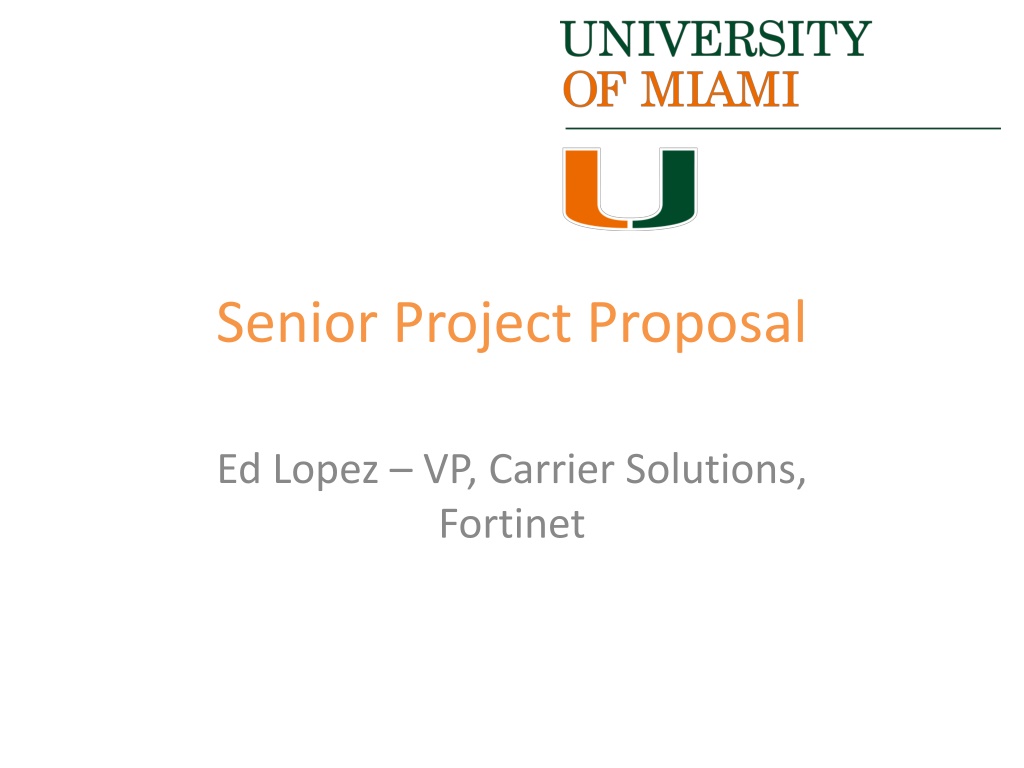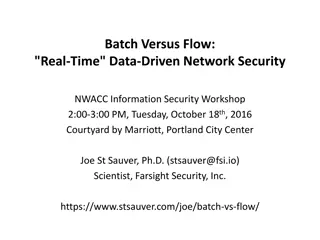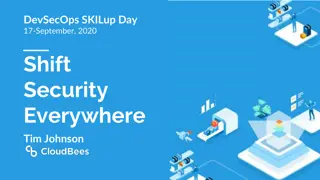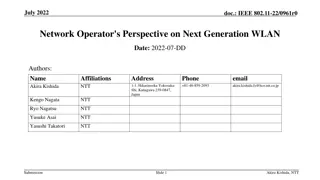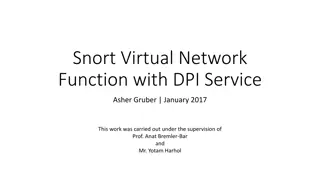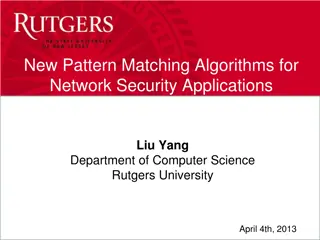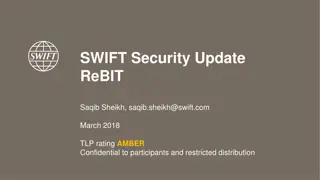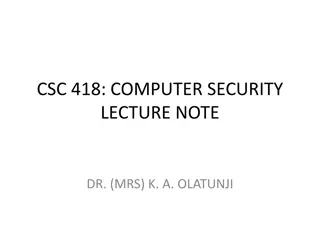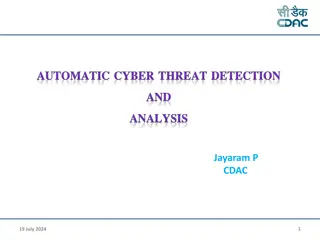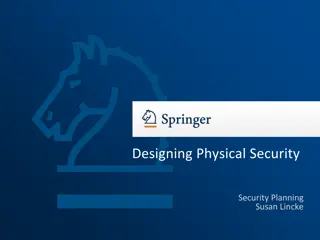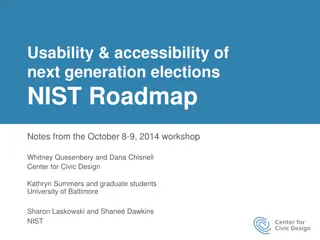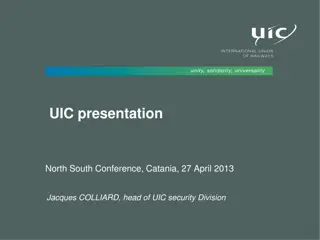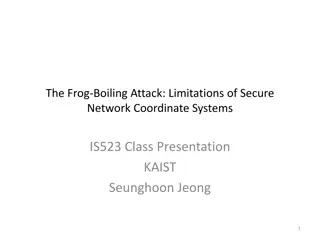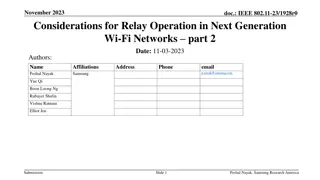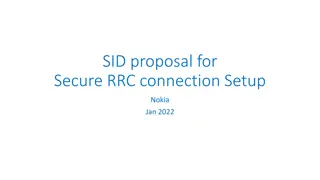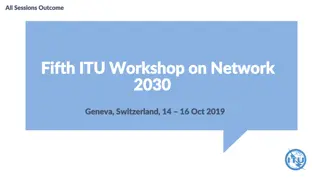Next-Generation Network Security Solutions for Evolving Challenges
Global IP traffic is rapidly increasing, with mobile data traffic outpacing fixed traffic. The shift to BYOD and cloud services is reshaping network security needs. Challenges include processing video traffic, evolving security appliances, and meeting bandwidth demands. Fortinet offers scalable security solutions like FortiGate appliances to address these issues effectively.
Download Presentation

Please find below an Image/Link to download the presentation.
The content on the website is provided AS IS for your information and personal use only. It may not be sold, licensed, or shared on other websites without obtaining consent from the author. Download presentation by click this link. If you encounter any issues during the download, it is possible that the publisher has removed the file from their server.
E N D
Presentation Transcript
Senior Project Proposal Ed Lopez VP, Carrier Solutions, Fortinet
A Changing Landscape Global IP traffic has increased fivefold over the past 5 years, and will increase threefold over the next 5 years Globally, mobile data traffic will increase 11-fold between 2013 and 2018 Global mobile data traffic will grow three times faster than fixed IP traffic from 2013 to 2018 Productivity shift from corporate devices to BYOD is shifting data/application control to application servers and the network Over half of all IP traffic will originate with non-PC devices by 2018 The number of devices connected to IP networks will be nearly twice as high as the global population by 2018 The emergence of cloud and data-center has radically redefined or even eliminated the network perimeter Cybercrime is a growing cost to individuals and organizations alike Network based security needs to evolve from a cost/compliance/liability model into a positive ROI model Fortinet Confidential Requires NDA
Imminent Challenges Moore s Law is no longer keeping up with growth inspecting application traffic at aggregation requires multiple processor solutions Network security appliances require network traffic to be directed to them for inspection, but this now needs to be performed at cloud/data-center aggregation points Video traffic now represents the majority of traffic, eclipsing web traffic (which previously eclipsed email traffic) network security must evolve to consider changing IMIXs and business models Ex.: Need to inspect data in depth, while only controlling access and forwarding of voice/video Virtualization of network assets is a massive orchestration challenge
Performance Challenge Security Needs To Keep Up With Bandwidth Requirements 1,000,000,000 1 Terabit 100 Gigabit 100,000 Core Networking Doubling ~18 mos Rate Mb/s 10 Gigabit 10,000 1,000 Gigabit Server I/O Doubling ~24 mos 100 1995 2000 2005 2010 2015 2020 Source : IEEE 802.3 Industry Connections Ethernet Bandwidth Assessment July 2012
1st Generation Security Scalable Appliances FortiGuard Performance & Scalability FortiOS FortiGate 30 90 (Access) FortiGate 100 800 (Edge NGFW) FortiGate 1000 5000 (Edge NGFW or Core DC) Entry Level Mid Level High End
2nd Generation Scalability - Clustering Using a combination of load- balancing combined with data normalization, develop multi- device solutions that act as a single inline device Stateless or session aware load- balancing Data normalization of routing tables, ARP tables, device configuration, authentication states, etc. Performed in chassis or via the use of external load-balancers Cluster size limits, based on number of devices, chassis size, number of ports, etc.
3rd Generation Scalability SDN & NFV Network Function Virtualization is the ability to provide virtualized network services within hypervisor-based environments Fortinet provides an array of VM-based products that integrate into NFV environments Software-Defined Networking is a way to describe abstracting network functions in order to virtualize or control by software. This is done by decoupling the operating system (software) that makes decisions about where network traffic is sent from the underlying hardware that forwards traffic to the selected destinations Use of SDN flow-programmable devices to shunt traffic of interest to an array of security and monitoring appliances Security Without Limits , as performance limits are shifted from in-line security devices to line-rate performance of the network architecture
FortiCore Providing Security Without Limits , FortiCore is an SDN flow programmable appliance which can distribute traffic of interest across an array of network security and monitoring appliances, while maintaining line-rate performance on a high-speed network link Link-based vs. node-based security/monitoring where its needed (network instrumentation) Only shunts traffic of interest, while maintaining high bandwidth, low-latency performance on 40G/100G links Two FortiCore Models Shipping 1H 2015 FortiCore 6100A Two 100G Interfaces, twenty-four 10G interfaces FortiCore 6040A Two 40G interfaces, forty-eight 10G interfaces
FortiCore 6100A Block Diagram AC Supply Gfd wqaq STORAGE X2 RAM Flash PSU PSU PCI-E Switch FPGA Switch Fabric Quad Core CPU 8 Core CPU FPGA MultiTable Pipeline FPGA MultiTable Pipeline FPGA MultiTable Pipeline FPGA MultiTable Pipeline RS-232 100G 100G SFP+ SFP+ SFP+ SFP+ SFP+ SFP+ SFP+ SFP+ SFP+ SFP+ SFP+ SFP+ SFP+ SFP+ SFP+ SFP+ SFP+ SFP+ SFP+ SFP+ SFP+ SFP+ SFP+ SFP+ USB 1G 1G
FortiCore OS Linux 3.14 kernel Support for Kernel Virtual Machine (KVM) hypervisor environment Will run a FortiSphere micro SDN controller as a virtual machine, to allow local programming of flows Support for OpenFlow 1.3.4 OpenFlow standard is maintained is by the Open Networking Foundation (ONF) https://www.opennetworking.org/images/stories/downloads/sdn- resources/onf-specifications/openflow/openflow-switch-v1.3.4.pdf Open vSwitch (OVS) is used as an OpenFlow agent, operating as an abstraction layer to program the FPGA switching matrix and pipelines via OpenFlow statements Configuration is managed via FortiOS shell CLI and GUI
FortiCore Link Transection (TRANSECT) FortiCore The FortiCore is inserted in a transected link between existing active components Traffic-of-interest is shunted to the FortiDevices associated with the FortiCore Other traffic is forwarded through maximizing transparency relative to the link traffic Link-based provides an network instrumentation model Can also replace existing (underperforming) in-line network security appliances
FortiCore Differential Routing (DIFFROUTE) DATA CENTER ENTERPRISE FortiCore CGN FortiEdge FortiEdge Traffic Encapsulation & Differential Routing Application-Based Forwarding FortiCore Traffic Encapsulation Aggregation Programable Forwarding Through Security Devices CGN Enforces Session Integrity Internet Routing
What Is Orchestration? Superflow A policy statement representing a bi-directional traffic flow Relative to SDN, a superflow can be broken down into individual uni- directional flow statements In the case of traffic-of-interest flowing through a FortiCore, a superflow breaks down into four individual flows: Organization -> FortiDevice FortiDevice -> Target Target -> FortiDevice FortiDevice -> Organization Orchestration is an tool that intelligently converts operational constructs (in this case policies/superflows) into control elements (in this case OpenFlow statements) Target FortiDevice FortiCore Organization
What Is An Organization? An organization represents a set of IP endpoints, such that traffic to/from the organization is subject to inspection Relative to FortiCore, an organization can be: Traffic which exists on an identifying VLAN on a transected link Only on a single VLAN tag, otherwise VLAN tag value is ignored A contiguous IP subnet (address/mask), including a single host Both of the above An organization is represented by a discrete set of OpenFlow flow match structures IN_PORT VLAN_VID IPV4_SRC/IPV6_SRC or IPV4_DST/IPV6_DST Depending on if the organization is the source or destination of the originating traffic flows in an IP session It is important to note that opposite structures are used for reply traffic flows in an IP session An organization is also represented by a similar set of discrete OpenFlow action structures OUTPUT PUSH_VLAN/POP_VLAN
What Is A FortiDevice? A FortiDevice is a network security device that can be associated with an organization s traffic A FortiDevice can be defined by OpenFlow flow match structures, if the security functions of that FortiDevice can be defined by a Layer 4 filter (IP protocol/port) Ex.: A web application firewall such as FortiWeb would be interested in TCP/80 and TCP/443 traffic by default IN_PORT, VLAN_VID, IP_PROTO & TCP_DST/UDP_DST/SCTP_DST/ICMP_TYPE, when evaluating originating traffic IN_PORT, VLAN_VID, IP_PROTO & TCP_SRC/UDP_SRC/SCTP_SRC/ICMP_TYPE, when evaluating reply traffic In any case, a FortiDevice can be defined as a set of OpenFlow action structures OUTPUT VLAN_VID
What Is A Target? The real purpose of the FortiCore device is to direct traffic-of-interest to/from an organization, through the appropriate FortiDevice for inspection Therefore a target is has a relatively vague definition IN_PORT & VLAN_VID within OpenFlow flow match structures OUTPUT & PUSH_VLAN/POP_VLAN within action structures There is a need for vagueness here, due to the best-match/first-match dilemma , associated with integrating stateless forwarders and stateful inspectors within a common networking solutions Stateless forwarders such as routers and switches, including SDN switches, make forwarding decisions based on best-match parameters Such as exact-match or longest-prefix match Stateful inspectors such as firewalls make forwarding decisions based on first-match parameters Better said that first-match parameters supercede best-match parameters A firewall policy table is a good example To resolve this, it is important to segregate forwarding responsibility between FortiCore and FortiDevices FortiCore is responsible to forward an organization s traffic to/from its appropriate FortiDevice FortiDevices are responsibility to filter and forward traffic based on opganization<>target policies
The Need For Orchestration Tools As FortiCore forwards traffic based on individual programmed flows, actually manually programming these flows would be a gargantuan task If a FortiCore supported 2,000 organizations, and each organization used up to four FortiDevices, this would represent 8,000 superflows to represent all of these associations With each superflow representing 4 flows, this represents 32,000 programmed flows What is needed is an orchestration solution to aid administrators in simplifying the task of generating the required number of programmed flows
Project Build An Orchestration Engine For FortiCore The solution must be open-source, or based on open-source tools No commercial tools are allowed to be used The resulting orchestration engine must remain open-sourced It must be delivered in the form of a virtual machine that can run on KVM It must incorporate an SDN controller that can support OpenFlow 1.3+ You have the freedom to choose any available open-source SDN controller, or build your own NTT s RYU controller is a favorite, and requires knowledge of Python It must have a database in support of definable objects, as well as storage of the programmed flows It must have a GUI for use in configuring the orchestration engine itself, as well as for inputting the required superflows Administrative ease-of-use will be a major factor in grading the project
